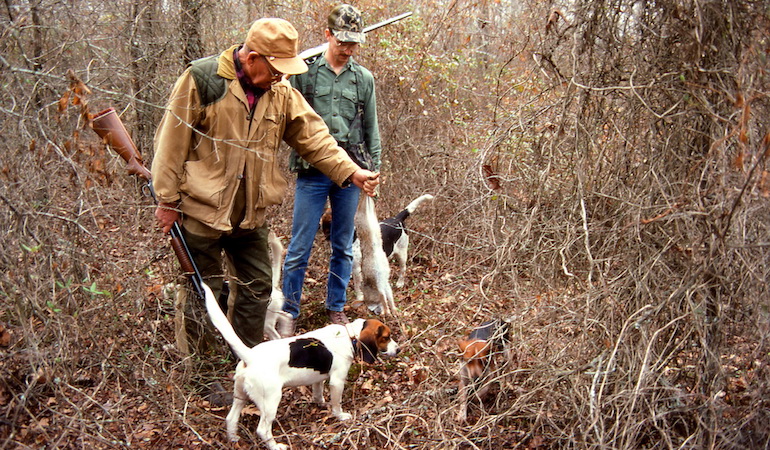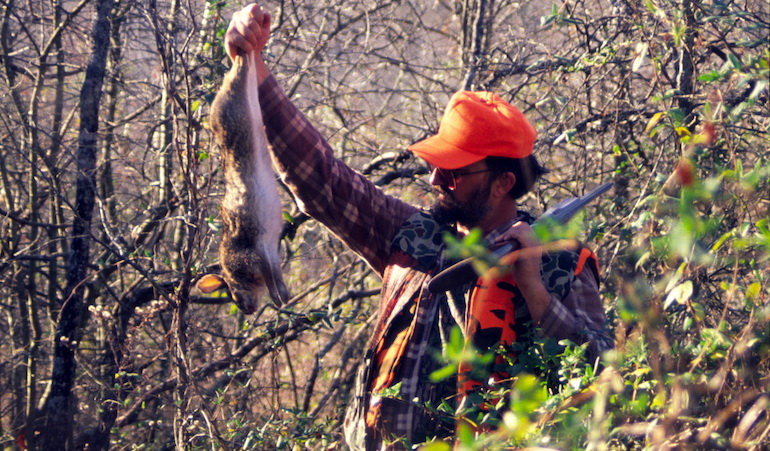
Whether hunting with dogs or without, today’s rabbit hunter often needs to frequent areas where dense, remote cover provides cottontails the best chance of survival. (Photo by Keith Sutton)
During recent decades, rabbit hunting has changed considerably from the cornucopia days seen by our fathers and grandfathers.
Bag limits were practically nonexistent until the 1960s, and during “the good ol’ days” grandpappy’s day of hunting was limited only by the money he had to spend on shotgun shells or by what he could carry in his game bag. Cottontails were plentiful then, but so were fencerows, fallow fields, brush piles and other features of prime rabbit cover.
Much of that habitat is gone now, tilled or cleaned up by farmers trying to make ends meet or lost to urban sprawl. Cottontails are left with fewer fencerows in which to hide from predators, fewer plants on which to browse and fewer grass clumps in which to catch some sun.
But, even though habitat loss has caused cottontails populations to decline from the bountiful levels of a few decades ago, rabbits still thrive in good numbers across their range. You might conclude otherwise after several meatless days afield, but cottontails are out there—just not where you can scare them up so easily.

Today, cottontails are more likely to hide out during daylight hours in dense, tight cover, leaving it to feed only after dark. They will locate secure cover spots that may be as much as half a mile from where they are feeding, visit the food at night and are back in the tight cover and hiding before dawn. So, visiting cover that’s remote from obvious hotspots often is a wise decision today. Plan to search longer and walk farther to find the thickets, brush piles and brambles where cottontails live.
Ten years ago, I might have taken my hunting buddies to a fallow farm field when searching for white-tailed sprinters. Killing limits of rabbits was a cinch, and we rarely bothered to contend with thorn-choked ditches and brush piles.
Now I’d rank such a field near the bottom of my list. Cover that rabbits used to prefer—what there is left of it—doesn’t suit them anymore. Instead of sitting in light cover, they head for the heaviest.

Now I’ll pick a big brush pile, a patch of honeysuckle or the toughest briar-covered hillside I can find as the place to hunt. Rabbits have changed their habits. They’re much more likely to live in the thickest cover available.
It pays to keep an eye out for those places other hunters tend to overlook. It may be a mile from the nearest road, and you may have to walk across open muddy fields to get to it, but those are some of the best rabbit hunting spots you can find.

For example, on one of my most successful days of rabbit hunting in recent years, my friends and I killed several dozen cottontails we flushed in a yard of old farm equipment that had overgrown with grass. Abandoned homesteads, old wood lots and fallen trees, especially those where the trunk is still rooted providing food for browsing rabbits, are also good places to look.
When there is a blanket of snow, look for rabbit tracks that lead to good cover and show no sign of exit. Then hunt the cover thoroughly.
Though it seems contrary to good sense, cold miserable days often provide the best gunning. Rabbit fur has poor insulating qualities, so rabbits are forced to take shelter from the weather, making them easier to find and less likely to flush wildly.
To find bad-weather bunnies, think like a rabbit. Where would you go to escape the cold if all you had to wear was a light jacket? Hunt places that are sheltered from wind and open to warm rays of sunshine, then move to other locales offering protection from adverse conditions.

Deep gullies, for example, provide shelter from wind and cold and are worthy of your inspection. Hunt them with the wind in your face if possible. If a breeze is hitting your back, the rabbit’s keen sense of hearing will often detect you before you’re in range. By walking into the wind, however, you can approach within shooting range of most cottontails before they hear you.
Instead of hunting all day in one large swath of brushy territory, you may need to try “leapfrogging,” where hunters cover one brush patch or overgrown fencerow in an hour or so, then drive on to another rabbit hideout. By doing this throughout the day, hunting first one spot then another, chances are good you’ll locate more rabbits.
It’s also a good idea to take time to befriend farmers and ask for their assistance in finding cottontail concentrations. Because they work their land daily and see rabbits regularly, they know where huntable populations are likely to be. Most are eager to keep cottontails thinned out so they don’t cause crop damage.

One you’ve done so, remember these things. Ask permission before hunting, every time you visit. Follow all rules the landowner asks you to abide by, like passing up shots at the coveys of quail he’s nurturing. Leave everything just as you found it, and always take time to thank the farmer personally. Offer to share your game, and follow up with a thank-you note and a token of your appreciation.
Make these easy-to-follow guidelines part of all your farm visits, and you’ll always have prime rabbit lands on which to hunt.











































